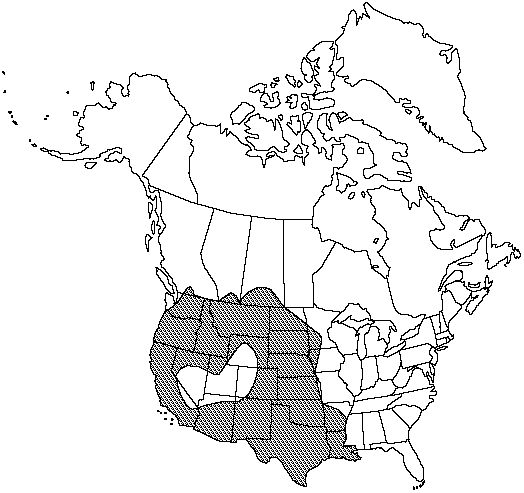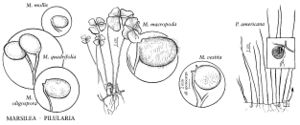Marsilea vestita
Icon. Filic. 2: plate 159. 1830.
Plants forming diffuse or dense clones. Roots arising at nodes. Petioles 2–20 cm, sparsely pubescent. Pinnae 4–19 × 4–16 mm, pubescent to glabrous. Sporocarp stalks erect, unbranched, attached at base of petiole (occasionally up to 3 mm above it), not hooked at apex, 0.5–25 mm. Sporocarps perpendicular or slightly nodding, 3.6–7.6 × 3–6.5 mm, 1.5–2 mm thick, elliptic to nearly round in lateral view, pubescent but soon glabrate, scars left by fallen trichomes often appearing as purple or brown specks; raphe 1.1–1.7 mm, proximal tooth 0.3–0.6 mm, blunt, distal tooth 0.4–1.2 mm, acute, often hooked at apex. Sori 14–22.
Habitat: Widespread and variable, in ponds and wet depressions and on river floodplains
Elevation: 0–2300 m
Distribution

Alta., B.C., Sask., Ariz., Ark., Calif., Colo., Idaho, Iowa, Kans., La., Minn., Mont., Nebr., Nev., N.Mex., N.Dak., Okla., Oreg., S.Dak., Tex., Utah, Wash., Wyo., Mexico, South America in Peru.
Discussion
A number of segregate species have been named and recognized in regional floras in North America: Marsilea mucronata A. Braun (less hairy, found east of Rocky Mountains), M. uncinata (glabrous, sporocarp stalks long, distal tooth of sporocarp hooked, south central United States), M. tenuifolia (pinnae very narrow, central Texas), and M. fournieri (small plants and pinnae, southwest). The features upon which these species are based intergrade into one another. The species are therefore best treated as conspecific with M. vestita (D. M. Johnson 1986).
Putative hybrids between Marsilea macropoda and this species are discussed under the former.
Selected References
None.
